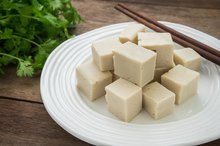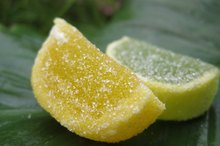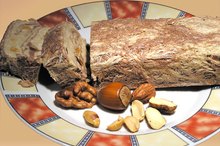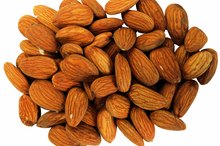What does fact checked mean?
At Healthfully, we strive to deliver objective content that is accurate and up-to-date. Our team periodically reviews articles in order to ensure content quality. The sources cited below consist of evidence from peer-reviewed journals, prominent medical organizations, academic associations, and government data.
- Journal of the American College of Nutrition: Whey Protein Supplementation During Resistance Training Augments Lean Body Mass
- Journal of the American College of Nutrition: Whey Protein Supplementation During Resistance Training Augments Lean Body Mass
- FamilyDoctor.org: Fiber: How to Increase the Amount in Your Diet
- Harvard School of Public Health: Three of the B Vitamins
- National Institute of Digestive and Diabetes and Kidney Disease: Lactose Intolerance
The information contained on this site is for informational purposes only, and should not be used as a substitute for the advice of a professional health care provider. Please check with the appropriate physician regarding health questions and concerns. Although we strive to deliver accurate and up-to-date information, no guarantee to that effect is made.
Nutritional Yeast Vs. Whey Protein Powder
Nutritional yeast and whey protein powder are both food supplements intended to boost overall nutrition, round out your diet and help you reach health goals. Each has a set of specific nutritional properties and purposes, so before you begin using either, it’s smart to learn more about what they offer and how they compare.
Nutrition Facts
A standard scoop of whey protein powder is about 30 grams, which is equivalent to approximately 1/4 cup. That amount of powder has about 110 calories, 2 grams of fat, 1 gram of carbohydrates, no fiber, 1 gram of sugar, 23 grams of protein and 35 milligrams of cholesterol. A standard serving of nutritional yeast is between 1 1/2 and 2 tablespoons, which is about 15 grams. However, it’s more accurate to double that amount for comparison to whey protein powder. A 30 gram scoop of nutritional yeast has about 140 calories, 2 grams of fat, 12 grams of carbohydrates, 8 grams of fiber, no sugar, 16 grams of protein and no cholesterol.
- A standard scoop of whey protein powder is about 30 grams, which is equivalent to approximately 1/4 cup.
- A standard serving of nutritional yeast is between 1 1/2 and 2 tablespoons, which is about 15 grams.
Components
Side Effects of Pure Virgin Olive Oil
Learn More
The nutrient breakdowns of whey protein and nutritional yeast are quite different. Protein powder, for example, gets more than 80 percent of its calories from protein, with a very small percentage coming from carbohydrates and about 15 percent coming from fat. Nutritional yeast has a more even breakdown; it gets approximately 50 percent of its calories from protein, 37 percent from carbohydrates and 13 percent from fat.
Purposes
Whey protein powder is commonly packaged and sold as a muscle-building supplement. While it does not build lean muscle mass by itself, the low-fat protein it contains can work in conjunction with a strength training program to encourage growth, repair and development of lean muscle mass, according to the 2013 issue of "Journal of the American College of Nutrition." Nutritional yeast provides nearly as much protein per serving as whey, but is far richer in dietary fiber and B vitamins 1. Fiber is essential for promoting digestive and bowel health, and B vitamins may work to protect against heart disease, cancer and birth defects, according to the Harvard School of Public Health.
- Whey protein powder is commonly packaged and sold as a muscle-building supplement.
- Fiber is essential for promoting digestive and bowel health, and B vitamins may work to protect against heart disease, cancer and birth defects, according to the Harvard School of Public Health.
Considerations
Does a Protein Powder Have Carbohydrates?
Learn More
While both nutritional yeast and whey protein powder can have positive functions in a healthy diet, it’s important to be cautious about the types you choose and how you use them. When they are packaged and sold as dietary supplements, the products are not subject to the same health regulations as those of whole foods, according to Beth Israel Deaconess Medical Center. Additionally, your regular diet may already meet nutritional needs without having to rely on supplements, so always check with your doctor before making any new item a fixture in your eating plan. If you have a milk allergy or lactose intolerance you should avoid any whey protein powder, according to Food Allergy Research and Education 4.
- While both nutritional yeast and whey protein powder can have positive functions in a healthy diet, it’s important to be cautious about the types you choose and how you use them.
- If you have a milk allergy or lactose intolerance you should avoid any whey protein powder, according to Food Allergy Research and Education 4.
Related Articles
References
- Journal of the American College of Nutrition: Whey Protein Supplementation During Resistance Training Augments Lean Body Mass
- FamilyDoctor.org: Fiber: How to Increase the Amount in Your Diet
- BIDMC.org: Diet Shakes and Meal Replacements - Can They Really Help You Lose Weight?
- Food Allergy Research and Education: Milk Allergy
- Gilbert, J.-A., Bendsen, N. T., Tremblay, A., & Astrup, A. (2011). Effect of proteins from different sources on body composition. Nutrition, Metabolism and Cardiovascular Diseases, 21, B16–B31. DOI: 10.1016/j.numecd.2010.12.008.
- Hulmi, J. J., Lockwood, C. M., & Stout, J. R. (2010). Effect of protein/essential amino acids and resistance training on skeletal muscle hypertrophy: A case for whey protein. Nutrition & Metabolism, 7(1), 51. DOI: 10.1186/1743-7075-7-51.
- Ridge, A., Devine, A., Lyons-wall, P., Conlon, J., & Lo, J. (2018). The impact of whey protein supplementation in older adults on nutrient intakes and satiety over an 11-week exercise intervention. Food Quality and Preference, 68, 72–79. DOI: 10.1016/j.foodqual.2018.01.013.
- Tahavorgar, A., Vafa, M., Shidfar, F., Gohari, M., & Heydari, I. (2014). Whey protein preloads are more beneficial than soy protein preloads in regulating appetite, calorie intake, anthropometry, and body composition of overweight and obese men. Nutrition Research, 34(10), 856–861. DOI: 10.1016/j.nutres.2014.08.015.
- Thomas, D. T., Erdman, K. A., & Burke, L. M. (2016). Position of the Academy of Nutrition and Dietetics, Dietitians of Canada, and the American College of Sports Medicine: Nutrition and Athletic Performance. Journal of the Academy of Nutrition and Dietetics, 116(3), 501–528. DOI: 10.1016/j.jand.2015.12.006.
- Zhu, K., Kerr, D. A., Meng, X., Devine, A., Solah, V., Binns, C. W., & Prince, R. L. (2015). Two-Year Whey Protein Supplementation Did Not Enhance Muscle Mass and Physical Function in Well-Nourished Healthy Older Postmenopausal Women. The Journal of Nutrition, 145(11), 2520–2526. DOI: 10.3945/jn.115.218297.
Writer Bio
Carly Schuna is a Wisconsin-based professional writer, editor and copy editor/proofreader. She has worked with hundreds of pieces of fiction, nonfiction, children's literature, feature stories and corporate content. Her expertise on food, cooking, nutrition and fitness information comes from a Level 1 personal training certification and years of in-depth study.









